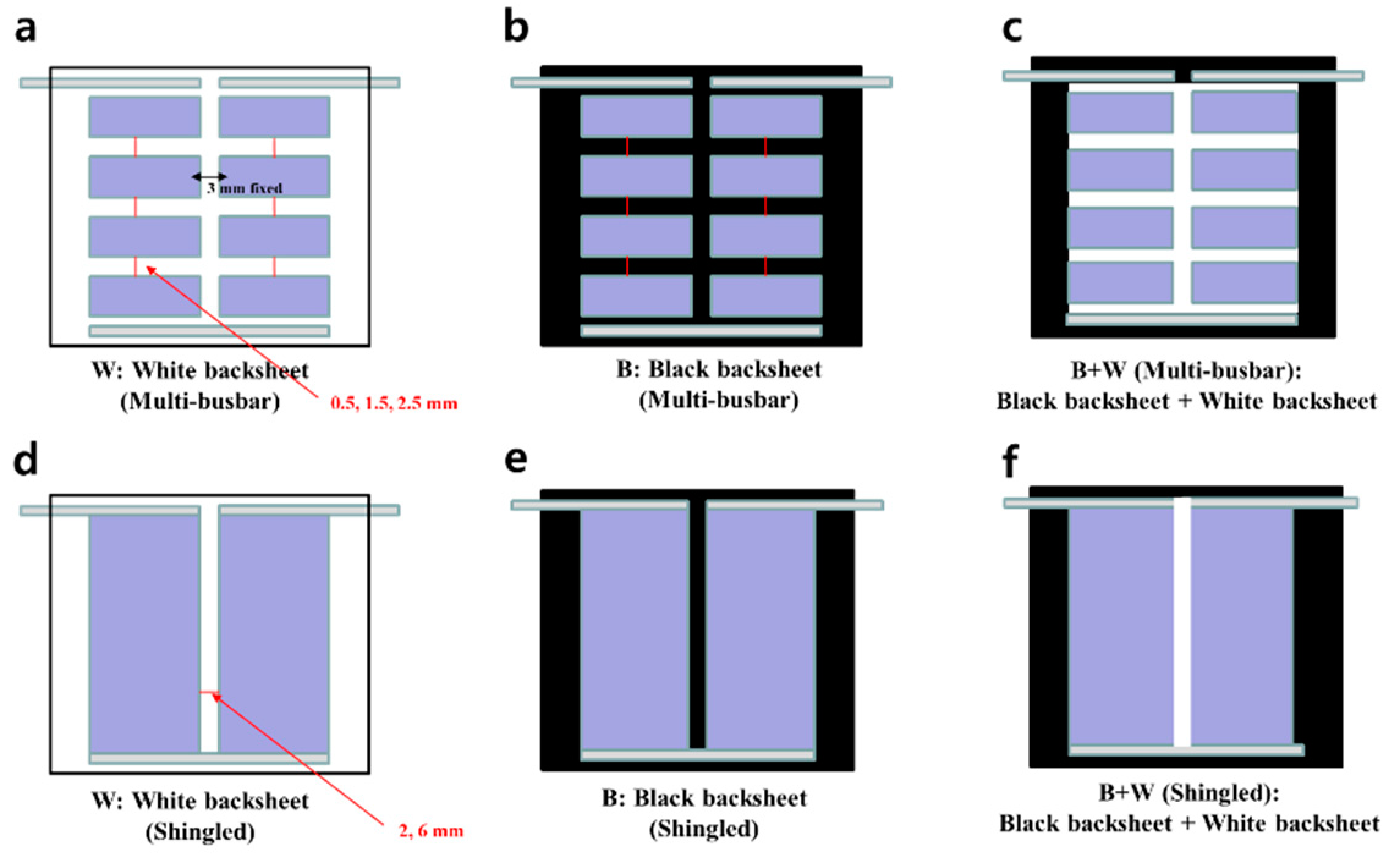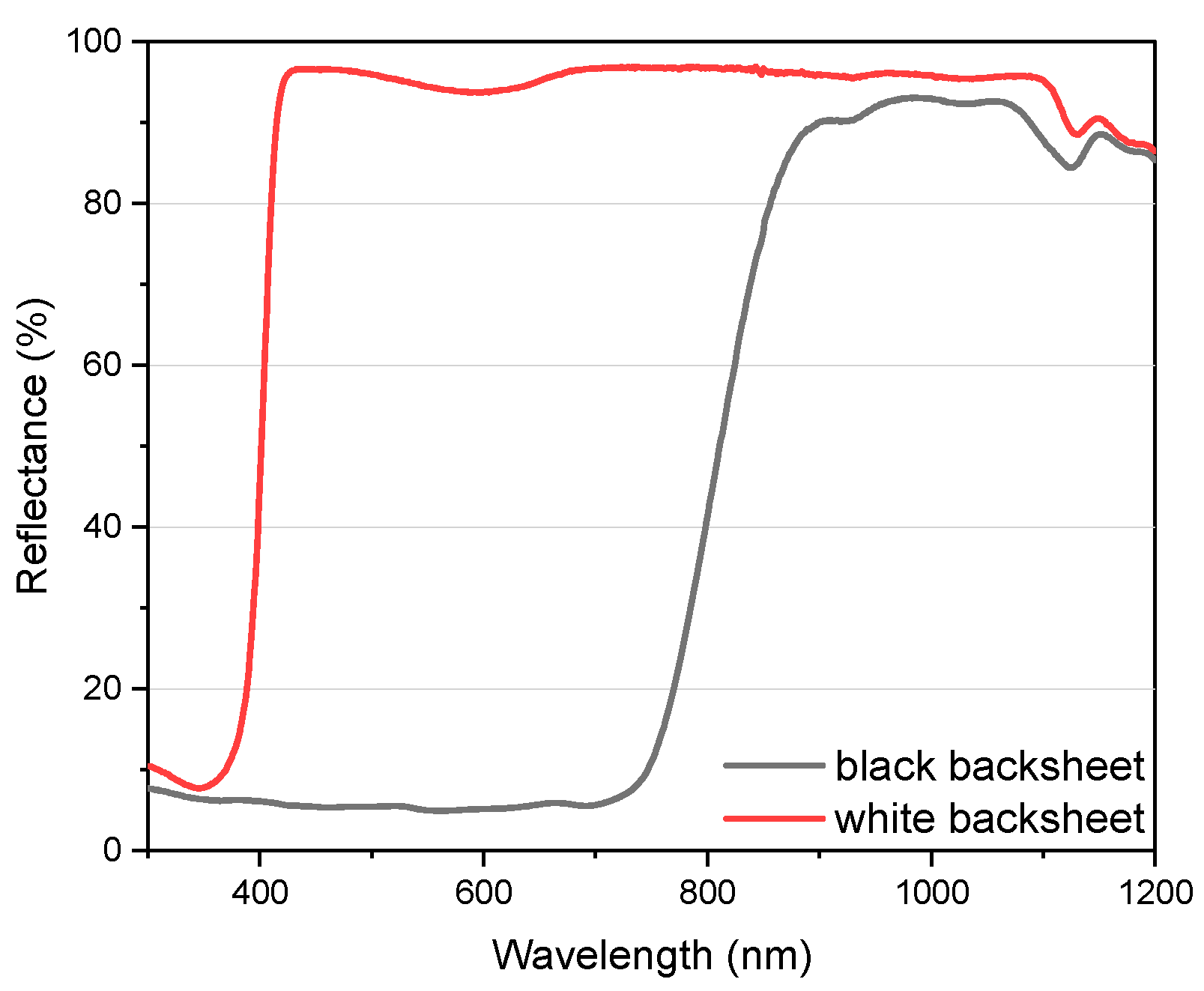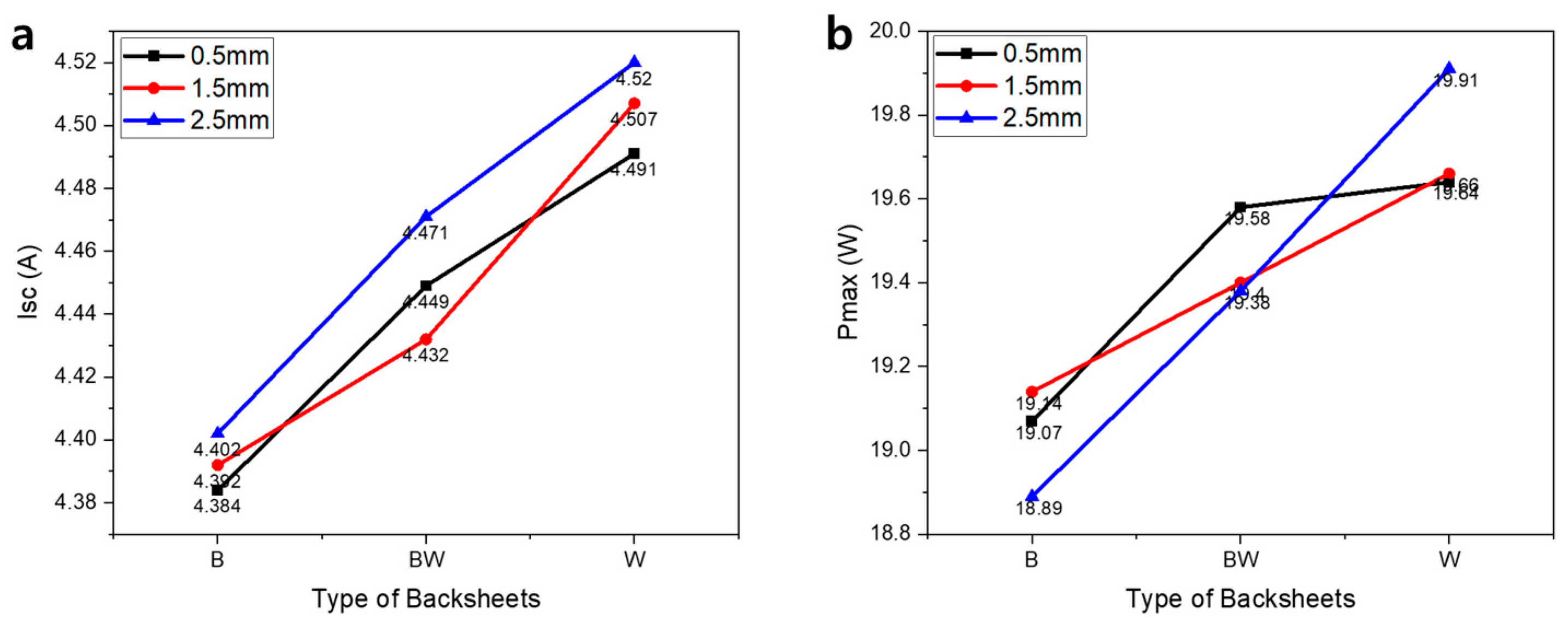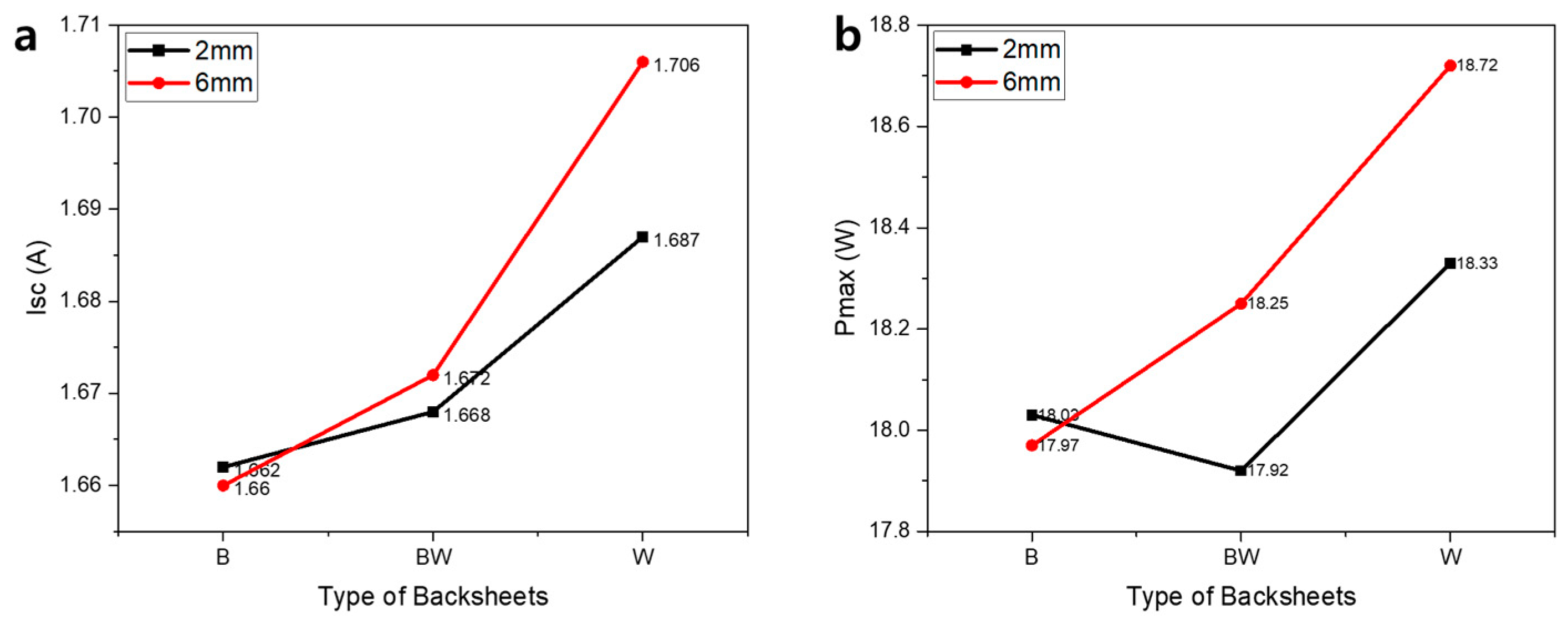Effects of Reflectance of Backsheets and Spacing between Cells on Photovoltaic Modules
Abstract
:1. Introduction
2. Materials and Methods
2.1. Materials
2.2. Methods
3. Results
3.1. Comparison of Backsheets
3.2. Comparison of Backsheets for MBB PV Modules
3.3. Comparison of Backsheets for Shingled PV Modules
4. Discussion
5. Conclusions
Supplementary Materials
Author Contributions
Funding
Institutional Review Board Statement
Informed Consent Statement
Data Availability Statement
Conflicts of Interest
Appendix A
| Space (0.5 mm) | B | B + W | W |
|---|---|---|---|
| Isc (A) | 4.384 | 4.449 | 4.491 |
| Voc (V) | 5.386 | 5.434 | 5.402 |
| Pm (W) | 19.07 | 19.58 | 19.64 |
| Ipm (A) | 4.18 | 4.251 | 4.296 |
| Vpm (V) | 4.561 | 4.607 | 4.572 |
| FF (%) | 80.76 | 81.02 | 80.95 |
| Space (1.5 mm) | B | B + W | W |
|---|---|---|---|
| Isc (A) | 4.392 | 4.432 | 4.507 |
| Voc (V) | 5.398 | 5.389 | 5.406 |
| Pm (W) | 19.14 | 19.4 | 19.66 |
| Ipm (A) | 4.196 | 4.248 | 4.296 |
| Vpm (V) | 4.561 | 4.567 | 4.576 |
| FF (%) | 80.72 | 81.21 | 80.69 |
| Space (2.5 mm) | B | B + W | W |
|---|---|---|---|
| Isc (A) | 4.402 | 4.471 | 4.520 |
| Voc (V) | 5.352 | 5.384 | 5.405 |
| Pm (W) | 18.89 | 19.38 | 19.91 |
| Ipm (A) | 4.188 | 4.262 | 4.351 |
| Vpm (V) | 4.510 | 4.546 | 4.576 |
| FF (%) | 80.16 | 80.50 | 81.50 |
| Space (2 mm) | B | B + W | W |
|---|---|---|---|
| Isc (A) | 1.662 | 1.668 | 1.687 |
| Voc (V) | 13.54 | 13.41 | 13.44 |
| Pm (W) | 18.03 | 17.92 | 18.33 |
| Ipm (A) | 1.580 | 1.587 | 1.616 |
| Vpm (V) | 11.41 | 11.29 | 11.34 |
| FF (%) | 80.09 | 80.15 | 80.85 |
| Space (6 mm) | B | B + W | W |
|---|---|---|---|
| Isc (A) | 1.66 | 1.672 | 1.706 |
| Voc (V) | 13.49 | 13.58 | 13.61 |
| Pm (W) | 17.97 | 18.25 | 18.72 |
| Ipm (A) | 1.576 | 1.589 | 1.628 |
| Vpm (V) | 11.41 | 11.49 | 11.50 |
| FF (%) | 80.25 | 80.51 | 80.60 |
References
- Ajayan, J.; Nirmal, D.; Mohankumar, P.; Saravanan, M.; Jagadesh, M.; Arivazhagan, L. A review of photovoltaic performance of organic/inorganic solar cells for future renewable and sustainable energy technologies. Superlattices Microstruct. 2020, 143, 106549. [Google Scholar] [CrossRef]
- Kafle, B.; Goraya, B.S.; Mack, S.; Feldmann, F.; Nold, S.; Rentsch, J. TOPCon—Technology options for cost efficient industrial manufacturing. Sol. Energy Mater. Sol. Cells 2021, 227, 111100. [Google Scholar] [CrossRef]
- Yousuf, H.; Khokhar, M.Q.; Chowdhury, S.; Pham, D.P.; Kim, Y.; Ju, M.; Cho, Y.; Cho, E.-C.; Yi, J. A Review on TOPCon Solar Cell Technology. Curr. Photovolt. Res. 2021, 9, 75–83. [Google Scholar]
- Wang, Q.; Wu, W.; Li, Y.; Yuan, L.; Yang, S.; Sun, Y.; Yang, S.; Zhang, Q.; Cao, Y.; Qu, H.; et al. Impact of boron doping on electrical performance and efficiency of n-TOPCon solar cell. Sol. Energy 2021, 227, 273–291. [Google Scholar] [CrossRef]
- Anand, N.; Kale, P. Optimization of TOPCon Structured Solar Cell Using AFORS-HET. Trans. Electr. Electron. Mater. 2021, 22, 160–166. [Google Scholar] [CrossRef]
- Feldmann, F.; Simon, M.; Bivour, M.; Reichel, C.; Hermle, M.; Glunz, S.W. Efficient carrier-selective p- and n-contacts for Si solar cells. Sol. Energy Mater. Sol. Cells 2014, 131, 100–104. [Google Scholar] [CrossRef]
- Feldmann, F.; Bivour, M.; Reichel, C.; Steinkemper, H.; Hermle, M.; Glunz, S.W. Tunnel oxide passivated contacts as an alternative to partial rear contacts. Sol. Energy Mater. Sol. Cells 2014, 131, 46–50. [Google Scholar] [CrossRef]
- Richter, A.; Benick, J.; Müller, R.; Feldmann, F.; Reichel, C.; Hermle, M.; Glunz, S.W. Tunnel oxide passivating electron contacts as full-area rear emitter of high-efficiency p-type silicon solar cells. Prog. Photovolt. Res. Appl. 2018, 26, 579–586. [Google Scholar] [CrossRef]
- Gao, T.; Yang, Q.; Guo, X.; Huang, Y.; Zhang, Z.; Wang, Z.; Liao, M.; Shou, C.; Zeng, Y.; Yana, B.; et al. An industrially viable TOPCon structure with both ultra-thin SiOx and n+-poly-Si processed by PECVD for p-type c-Si solar cells. Sol. Energy Mater. Sol. Cells 2019, 200, 109926. [Google Scholar] [CrossRef]
- Kim, K.; Lee, S.; Chowdhury, S.; Yi, J. A Brief Review of Passivation Materials and Process for High Efficiency PERC Solar Cell. Trans. Electr. Electron. Mater. 2021, 1–5. [Google Scholar] [CrossRef]
- Rain, G.; Sinha, S. A simulation study to evaluate and compare monofacial Vs bifacial PERC PV cells and the effect of albedo on bifacial performance. Mater. Today Proc. 2021, 46, 5242–5247. [Google Scholar] [CrossRef]
- Dullweber, T.; Schmidt, J. Industrial Silicon Solar Cells Applying the Passivated Emitter and Rear Cell (PERC) Concept—A Review. IEEE J. Photovolt. 2016, 6, 1366–1381. [Google Scholar] [CrossRef]
- Tong, R.; Zhang, W.; Ke, X.; Liu, Z. Influence of surface structure on the performance of mono-like Si PERC solar cell. Mater. Sci. Semicond. Process 2021, 126, 105662. [Google Scholar] [CrossRef]
- Green, M.A. The Passivated Emitter and Rear Cell (PERC): From conception to mass production. Sol. Energy Mater. Sol. Cells 2015, 143, 190–197. [Google Scholar] [CrossRef]
- Blakers, A. Development of the PERC Solar Cell. IEEE J. Photovolt. 2019, 9, 629–635. [Google Scholar] [CrossRef]
- Panigrahi, J.; Komarala, V.K. Progress on the intrinsic a-Si:H films for interface passivation of silicon heterojunction solar cells: A review. J. Non. Cryst. Solids 2021, 574, 121166. [Google Scholar] [CrossRef]
- Xia, Y.; Dai, D. Review on applications of PEDOTs and PEDOT:PSS in perovskite solar cells. J. Mater. Sci. Mater. 2021, 32, 12746–12757. [Google Scholar] [CrossRef]
- Qu, X.; He, Y.; Qu, M.; Ruan, T.; Chu, F.; Zheng, Z.; Ma, Y.; Chen, Y.; Ru, X.; Xu, X.; et al. Identification of embedded nanotwins at c-Si/a-Si:H interface limiting the performance of high-efficiency silicon heterojunction solar cells. Nat. Energy 2021, 6, 194–202. [Google Scholar] [CrossRef]
- Park, H.; Ju, M.; Khokhar, M.Q.; Cho, E.-C.; Kim, Y.; Cho, Y.; Yi, J. Surface Modifications for Light Trapping in Silicon Heterojunction Solar Cells: A Brief Review. Trans. Electr. Electron. Mater. 2020, 21, 349–354. [Google Scholar] [CrossRef]
- Masuko, K.; Shigematsu, M.; Hashiguchi, T.; Fujishima, D.; Kai, M.; Yoshimura, N.; Yamaguchi, T.; Ichihashi, Y.; Mishima, T.; Matsubara, N.; et al. Achievement of More Than 25% Conversion Efficiency With Crystalline Silicon Heterojunction Solar Cell. IEEE J. Photovolt. 2014, 4, 1433–1435. [Google Scholar] [CrossRef]
- Wolf, S.D.; Descoeudres, A.; Holman, Z.C.; Ballif, C. High-efficiency Silicon Heterojunction Solar Cells: A Review. Green 2012, 2, 7–24. [Google Scholar] [CrossRef]
- Jensen, N.; Hausner, R.M.; Bergmann, R.B.; Werner, J.H.; Rau, U. Optimization and Characterization of Amorphous/Crystalline Silicon Heterojunction Solar Cells. Prog. Photovolt: Res. Appl. 2002, 10, 1–13. [Google Scholar] [CrossRef]
- Mittag, M.; Zech, T.; Wiese, M.; Bläsi, D.; Ebert, M.; Wirth, H. Cell-to-Module (CTM) Analysis for Photovoltaic Modules with Shingled Solar Cells. In Proceedings of the 2017 IEEE 44th Photovoltaic Specialist Conference (PVSC), Washington, DC, USA, 25−30 June 2017; pp. 1531–1536. [Google Scholar]
- Jun, D.; Son, H.; Moon, J.; Cho, S.; Kim, S.H. A Study on Correlation Peel Strength and the Efficiency of Shingled Modules According to Curing Condition of Electrically Conductive Adhesives. Curr. Photovolt. Res. 2021, 9, 31–35. [Google Scholar]
- Kim, J.; Kim, J.; Jeong, C.; Choi, W.; Lee, J. Study on Shingled String Interconnection for High Power Solar Module. J. Korean Inst. Electr. Electron. Mater. Eng. 2021, 34, 449–453. [Google Scholar]
- Oh, W.; Park, J.; Dimitrijev, S.; Kim, E.K.; Park, Y.S.; Lee, J. Metallization of crystalline silicon solar cells for shingled photovoltaic module application. Sol. Energy 2020, 195, 527–535. [Google Scholar] [CrossRef]
- Braun, S.; Hahn, G.; Nissler, R.; Pönisch, C.; Habermann, D. The multi-busbar design: An overview. Energy Procedia 2013, 43, 86–92. [Google Scholar] [CrossRef] [Green Version]
- Park, J.E.; Choi, W.S.; Lim, D. Cell/Module Integration Technology with Wire-Embedded EVA Sheet. Appl. Sci. 2021, 11, 4170. [Google Scholar] [CrossRef]
- Jiang, Y.; Huang, G.; Zhuang, H.; Sun, G.; Li, J. Energy simulation of p-PERC bifacial modules based on different installation environment. IOP Conf. Ser. Earth Environ. Sci. 2021, 675, 012188. [Google Scholar] [CrossRef]
- Kim, N.; Lee, S.; Zhao, X.G.; Kim, D.; Oh, C.; Kang, H. Reflection and durability study of different types of backsheetsand their impact on c-Si PV module perform. Sol. Energy Mater. Sol. Cells 2016, 146, 91–98. [Google Scholar] [CrossRef]
- Vogta, M.R.; Holsta, H.; Schulte-Huxela, H.; Blankemeyera, S.; Wittecka, R.; Bujardb, P.; Kuesc, J.-B.; Schinked, C.; Bothea, K.; Köntgesa, M.; et al. PV module current gains due to structured backsheets. Energy Procedia 2017, 124, 495–503. [Google Scholar] [CrossRef] [Green Version]
- Saw, M.H.; Khoo, Y.S.; Singh, J.P.; Wang, Y. Cell-to-module optical loss/gain analysis for various photovoltaic module materials through systematic characterization. Jpn. J. Appl. Phys. 2017, 56, 08MD03. [Google Scholar] [CrossRef]




Publisher’s Note: MDPI stays neutral with regard to jurisdictional claims in published maps and institutional affiliations. |
© 2022 by the authors. Licensee MDPI, Basel, Switzerland. This article is an open access article distributed under the terms and conditions of the Creative Commons Attribution (CC BY) license (https://creativecommons.org/licenses/by/4.0/).
Share and Cite
Lim, H.; Cho, S.H.; Moon, J.; Jun, D.Y.; Kim, S.H. Effects of Reflectance of Backsheets and Spacing between Cells on Photovoltaic Modules. Appl. Sci. 2022, 12, 443. https://doi.org/10.3390/app12010443
Lim H, Cho SH, Moon J, Jun DY, Kim SH. Effects of Reflectance of Backsheets and Spacing between Cells on Photovoltaic Modules. Applied Sciences. 2022; 12(1):443. https://doi.org/10.3390/app12010443
Chicago/Turabian StyleLim, Hyunsoo, Seong Hyeon Cho, Jiyeon Moon, Da Yeong Jun, and Sung Hyun Kim. 2022. "Effects of Reflectance of Backsheets and Spacing between Cells on Photovoltaic Modules" Applied Sciences 12, no. 1: 443. https://doi.org/10.3390/app12010443






